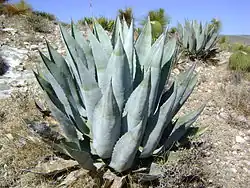Agave scabra
| Agave scabra | |
|---|---|

| |
| Scientific classification | |
| Kingdom: | Plantae |
| Clade: | Tracheophytes |
| Clade: | Angiosperms |
| Clade: | Monocots |
| Order: | Asparagales |
| Family: | Asparagaceae |
| Subfamily: | Agavoideae |
| Genus: | Agave |
| Species: | A. scabra
|
| Binomial name | |
| Agave scabra | |
| Synonyms[1] | |
| |
Agave scabra (synonym Manfreda scabra), also known as rough leaved agave, is a member of the subfamily Agavoideae.[1][2]
Description
Agave scabra has rosettes growing 0.7–1 metre (2.3–3.3 ft) in height and 1.5–2 metres (4.9–6.6 ft) in width.[2] It is similar in form to many other agaves. The rosettes are suckering.
The glaucous bluish-green leaves are mostly reflexed and rough (like sand-paper). The inflorescence is up to 4.5 metres (15 ft) in height, with yellow flowers during the summer.[2]
Distribution
It is native to the Chihuahuan Desert and surrounding regions, in northeastern Mexico and Texas.[2] It grows at elevations of 500–1,500 metres (1,600–4,900 ft).[2]
References
Wikimedia Commons has media related to Agave scabra.
- ^ a b c "Agave scabra", World Checklist of Selected Plant Families, Royal Botanic Gardens, Kew, retrieved 2019-04-13
- ^ a b c d e llifle.com: Manfreda scabra